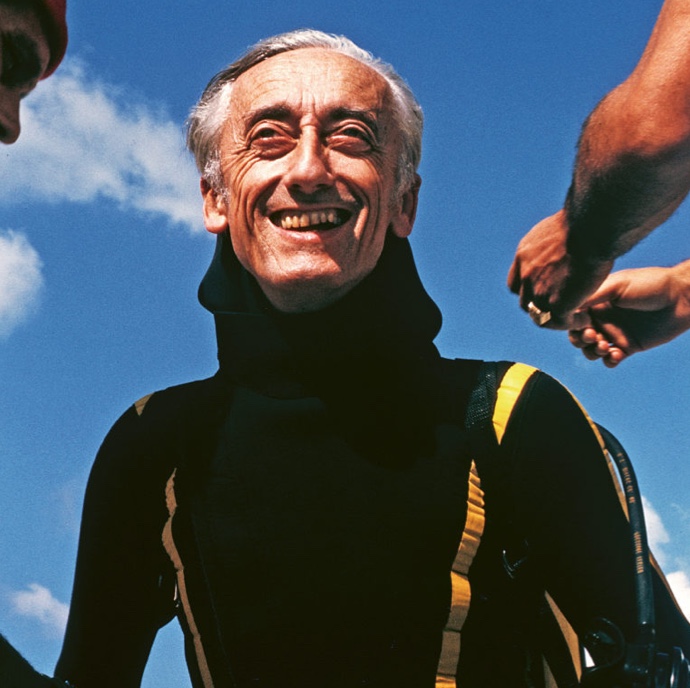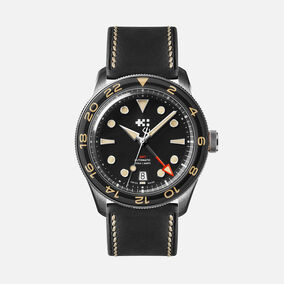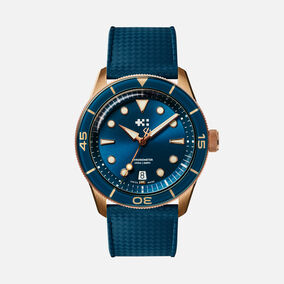One of the key inspirations for the new Aquitaine watch series, Jacques Cousteau invented the modern wildlife documentary and brought the wonder of the oceans into people’s houses for the first time
For Jacques Cousteau, water was freedom. When you swam in water you escaped – no, defeated! – the gravity that held you down on dry land.
Born in June 1910, Jacques-Yves Cousteau longed to venture away from his home in the Gironde, south-west France. The urge to explore defined him. But it wasn’t his only passion.
From the age of 13, Cousteau carried a cine camera with him, recording family celebrations, quiet moments of work and play in and around the house.
In 1930, he joined the École Navale, France’s naval academy where he trained to be a pilot. But a car accident that broke both his arms put paid to his aeronautical ambitions, so instead he directed his inquisitiveness to the sea, and in particular, underwater diving (which helped with his recovery from the accident).
In 1936, his friend Philippe Tailliez lent him a pair of Fernez goggles, which kickstarted his interest in using engineering to increase the amount of time divers could spend underwater. This eventually led him to working with engineer Émile Gagnan in the winter of 1942-43 on the invention of the ‘aqua-lung’, a self-contained breathing apparatus that allowed divers to swim deeper and for longer than ever before.
“To swim fishlike, horizontally, was the logical method in a medium 800 times denser than air,” said Cousteau. “To halt and hang attached to nothing, no lines or air pipe to the surface, was a dream. At night I had often had visions of flying by extending my arms as wings. Now I flew without wings.”
“If we are not willing to change, we will disappear from the face of the globe”

For Cousteau, however, being able to explore wasn’t enough: he had to share his experiences, too – via his favourite medium, film. As he and his friends expanded their operations to include Mediterranean shipwrecks and interactions with marine wildlife, he released two documentaries in 1943: Par dix-huit mètres de fond (18 Metres Deep) and Épaves (Shipwreck).
Over time he acquired a boat, an ex-Royal Navy minesweeper, the Calypso; a group of loyal shipmates, and most important of all, a wife, Simone, who loved the ocean more than he did. She, and the children and grandchildren that followed, became his constant companions at sea.
But it was another film which finally brought the world to Cousteau’s door. He’d been working for BP as they searched the waters around Abu Dhabi for oil, and took an underwater film crew with him to record his experiences. The footage eventually became 1956’s The Silent World.
The first documentary to win the Palme D’Or prize at Cannes, it gave viewers the chance to see aquatic life for the first time. Sharks! Whales! Crabs! What they did, how they ate, where they lived – it was all there. Jacques just had to point his camera at it.
By now, Cousteau had acquired a sizable crew, some of whom would become nearly as famous as him. With their suntanned skin, sea-chiselled faces and Tony Curtis hair, they looked like they’d walked straight off a film set. Best of all was Jacques: handsome in that angular, Gitanes-puffing French way, his chambray shirt accentuating the tan – and atop his head, the iconic red beanie hat, his unmistakable trademark.
So when in 1968 The Undersea World of Jacques Cousteau was commissioned by ABC television he was perfectly placed to bring the wonder of the ocean to a worldwide audience. Each episode had a scientific or research hook, and took the form of a perfectly paced drama.
There would be danger, awe, intrigue, joy, and then, when the crew returned to the Calypso for some well-deserved wine and good food – he was French after all – they’d chat about the day’s adventures. What a gang!
Cousteau’s goal was to get his audience to realise how intrinsic the oceans were to their existence. And while his fame had partly come from his oil exploration work, by the 1980s he was a passionate campaigner for marine preservation.
”If we are not willing to change,” he said. “We will disappear from the face of the globe, to be replaced by the insect.”
After 36 episodes, The Undersea World ended but Cousteau made films and campaigned on environmental issues until his death in 1997. His legacy was huge: 120 TV documentaries, more than 50 books, and a foundation with 300,000 members. Truly, a force of (and for) nature.

Related watches

Sign up to Loupe magazine
Loupe is Christopher Ward’s quarterly in-house magazine. If you want to know what’s happening at CW (and you love great journalism), this is where to start. Alternatively, you can read all our back issues on your computer, tablet or phone.
Order your free copyRead Loupe online




